Using serpyanka tape
Decorating the joints of sheets with a serpentine is a fairly common practice. This is an adhesive fiberglass mesh impregnated with special compounds, which, due to this, easily fits on any surface. A tape is used for the joints of drywall, giving them strength and preventing the appearance of cracks, which inevitably form with the wrong technology. Since serpyanka is glued between layers of putty, it is protected from an alkaline environment - during its manufacture it is impregnated with a special polyacrylate dispersion. In order to get a good grip and a flat surface, you need to know some of the intricacies of working with this material.
How to use serpyanka?
- Prepare a piece of the required length.
- Mix in some putty.
- Using a small spatula, gently apply it in the middle of the seam to the length corresponding to the section of the serpentine.
- Attach the prepared piece of tape to the seam and press it into the putty.
- On top with a spatula, trying to keep it at an acute angle, apply a thin layer of mortar.
- Once dry, remove any unevenness with a sander or sandpaper.
That's all. If you know the basics of how to glue serpyanka, this process will not cause any difficulties.
Using paper reinforcement tape
When making joints with increased requirements for strength, as well as when using putties based on artificial resins, paper tape for drywall joints is indispensable. It can also be used for finishing horizontal joints, where the smallest irregularities are immediately striking, since it has a small thickness. It is quite simple to work with it.
- Dilute a small amount of putty.
- Apply it to the joints and coat well with longitudinal movements.
- For the paper reinforcement tape to have better adhesion to the surface, moisten it.
- Apply the strip to the applied mortar, being careful to center the strip on the joining line of the sheets.
- Holding the joint tape by one end, run the trowel to the opposite side with light pressure.
- Remove excess solution.
If you do everything correctly, the drywall tape will lie flat and will not protrude above its surface.
How to glue serpyanka - glue review
Self-adhesive serpyanka is always covered with adhesive on one side. Although it is intended for self-gluing, you should not rely heavily on the adhesive that is already applied to the mesh.
Standard glue is not able to securely fix the material on the work surface alone. It will peel off and this will degrade the quality of the repair. To avoid such problems, additional adhesives must be used.
For a strong bond, craftsmen often use putty or plaster.
Glue will be no less effective:
- PVA. Water-based universal adhesive with a creamy consistency. Firmly adheres serpyanka, paper, cardboard, wallpaper, plywood, tiles, glass, wood, fabrics and porcelain. The cost of a package weighing 1 kg: 69 rubles.
- Bustilat. Construction glue with a wide spectrum of action, intended for serpyanka, wallpaper, fiberboard, chipboard, linoleum, ceramic tiles and many other materials. It perfectly fixes decorative elements on the ceiling and walls. It is a white-gray mass. The cost of a package weighing 1.2 kg: 70 rubles.
It is easy to glue the tape to the ceiling, but making it so that it lasts there for a long time is much more difficult.
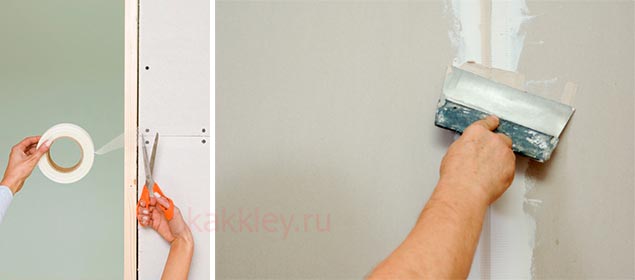
Gravity causes it to peel off at the edges.To avoid this, a thicker primer layer is applied to the ceiling, after which the edges of the serpyanka tape are smeared with the aforementioned Bustilat or PVA glue with a thin brush.
Craftsmen often glue a reinforcing construction mesh to the ceiling, pressing it evenly into a fresh layer of putty. This is a more difficult but very powerful method.
Which serpyanka is the most reliable?
The quality of gluing with a serpyanka largely depends not only on the use of additional adhesives, but also on the reinforcing tape itself.
Therefore, it is very important to choose a quality product:
- Axton 45 mm x45 m. Axton offers excellent tapes for finishing corners, seams and crevices, holding putty and plaster in joints, as well as continuous surface reinforcement. It is universal, as it can be used with other materials: concrete, wood, drywall, etc. And it costs only 67 rubles apiece.
- Semin 150 m. Tape for plasterboard joints made of corrugated paper. Moisture-proof and resistant to soaking and tearing. Forms and protects the edges of the corners of plasterboard structures. The web of such a tape adheres well to the surface. Also, the serpyanka can be glued to the damp putty. The material is made from environmentally friendly substances. Price: 388 rubles apiece.
Serpyanka self-adhesive feature and scope
As already mentioned, this material is a construction mesh based on fiberglass. A special glue is applied on top of the tape, which allows you to firmly attach it to drywall. The main characteristics of this repair material are:
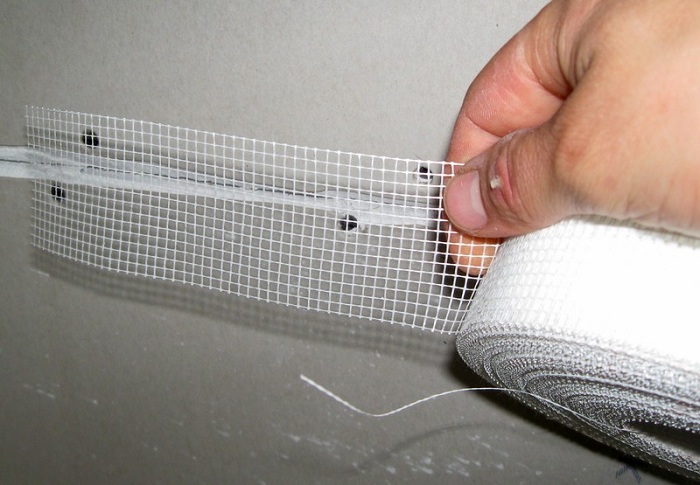
- The shelf life from the date of manufacture is three years, then the manufacturer does not guarantee the correct operation of the adhesive.
- Construction serpyanka is presented in the form of tape winding on a cardboard sleeve. The cross section is 5 millimeters.
- Its width will fluctuate depending on the preference of buyers from 40 to 230 mm. The length varies from 2 to 18 centimeters.
Self-adhesive tape serpyanka can be glued to absolutely any seams of the material, whether end or family ones, which are characterized by the presence of recesses. Its absence on drywall seams will be an absolute guarantee that a crack will eventually appear on the seam.
Serpyanka self-adhesive, where to find your application. In addition, it can be used as a reinforcing material for joints, which are made of two materials of different shapes. For example, it will be possible to reinforce the joints of the wall made of wood and stone, stone and drywall, and so on.
Self-adhesive serpyanka has certain advantages, which makes it possible to use it in various repair work:
- Ease of use, installation is very fast regardless of the experience of use.
- It does not deform, regardless of displacement that may occur due to shrinkage, shear or vibration.
- The belt can withstand lateral and longitudinal loads, regardless of their level.
- Surfaces can be putty with various solutions, since serpyanka is resistant to alkalis, acids and any aggressive media.
- The tape has high adhesion to any building materials, in particular to drywall. In addition, the cells are perfectly sealed, the section is tight and reliable.
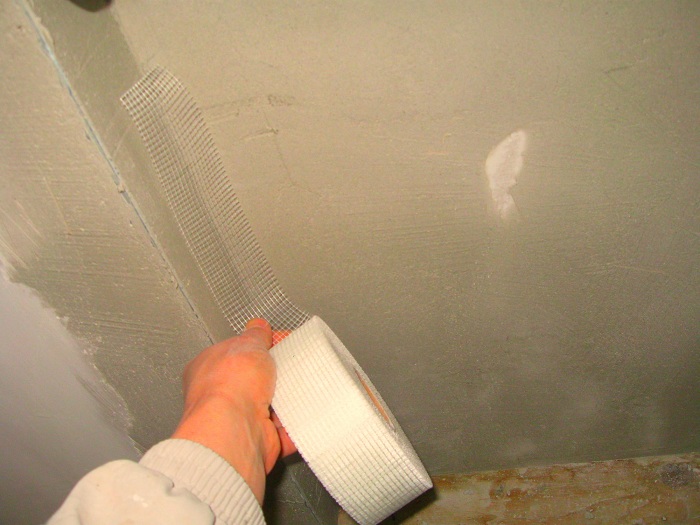
In addition to drywall, self-adhesive serpyanka, finds its use in reinforcing outer corners, places of abutment of door, as well as window frames directly to the walls. If alignment of walls and ceilings is necessary, then you also cannot do without the use of tape. It is also needed in the case of preparing walls for wallpapering, when a perfectly even layer is required.
With the help of it, you can increase the impact-resistant properties of any surface, since by its design it creates a semblance of a screed that does not allow the wall to disperse.
Application of paper tape for sealing joints on drywall
Paper tape for drywall seams is produced by many manufacturers, but the high quality of the Knauf trademark is noted. For the production of reinforcing tape, high quality raw materials are used, which are distinguished by their strength. Sealing drywall joints is a simple matter, but important.
Do not forget that the strength of the entire structure depends on this. Video for sealing drywall seams with paper tape. Knauf drywall paper tape is a quality material: The tape is penetrated throughout the strip with fiberglass. The paper tape is a little rough to the touch. This is for better adhesion to the putty. When creating gypsum plasterboard structures, joints appear on the ceiling and walls - the border of the connection of two sheets. The joint should be properly sealed, this serves as the strength of the entire structure. Drywall paper tape is one of the many materials for this purpose.
And you should also choose a putty that will hold for a long time. It looks like paper tape for sealing drywall seams There are such materials on the market for sealing drywall seams:
- It perfectly reinforces the seams, creating structural strength.
- The tape does not break after getting wet.
- It allows air to pass through well.
- It is not toxic to humans and animals.
This is how it is best to arrange the outer corner at the joints of drywall sheets, BUT, under the metal corner, it is best to still glue the paper tape for the gypsum board joints at an angle, if the surface is supposed to be painted, if it is possible under the wallpaper. It is better to attach metal corners to putty / plaster, first coating the corner with it, and then fixing the corner. In the photo, they are screwed onto self-tapping screws, which spoils the corner a little, it can be twisted, which will affect the quality of the finish. We embroidered the seams, primed them, the primer is dry.
It is better to close the seams with a special putty for gypsum board joints, for example, Fugenfuller (FUGEN) from Knauf. You can also use ordinary plaster mixed with a deep penetration primer, this method can also be suitable if you plan to putty drywall, since the plaster has a large fraction. There are some subtleties here. If you dilute the mixture in large quantities, for example, you will process a large surface area and you have a lot of workers, then using a construction mixer for mixing, do not use high speeds. This method involves a lot of additional air in the composition, and its excessive amount has a bad effect on the strength of the final product.
Grinding of the areas we need is done with ordinary sandpaper, an abrasive mesh, which are fixed on a special block, or with a special abrasive float. What to choose - decide for yourself.
- The material has an affordable cost.
- Due to the minimum thickness, it is possible to use even ready-made surfaces for strengthening.
- It goes well with putty and drywall, practically forming one whole with them after drying. This gives the seam extra strength.
Serpyanka is sometimes called a construction bandage: they are really very similar. It is a thin fiberglass mesh, one side of which is covered with a special adhesive. It should be stored in a bag to prevent the glue from drying out. Sealing of places between the sheets is carried out before the start of plastering work.
Most often, the fiberglass mesh is mounted on longitudinal seams. The technology for using serpyanka is as follows: In practice, for finishing work using gypsum boards for reinforcement and sealing, two types of reinforcing materials are used - paper tape for drywall seams and serpyanka. What's the difference between them?
Additional information on the topic:
- How to decorate a plasterboard partition in a room
- How much the room will decrease when sheathing with plasterboard
- How much distance to put suspensions on the ceiling for drywall
- What is better drywall or osb for interior partitions
- What is better to use drywall or gypsum fiber in the bathroom
GKL joints: boom. PVA tape - can I?
We are talking about specials. perforated paper tape for sealing joints, including corner joints - gypsum board / gypsum board or gypsum board / wall.
According to the technology, it is supposed to drive this tape into the putty.
Isn't it better, or at least not equivalent, to glue this tape on PVA (of course, for the case of gypsum board / gypsum board)? And putty on top.
There is a suspicion that such a technology is not officially proposed because Knauf does not make PVA glue (or does it? Or is this not the reason? Or does such a technology even exist?).
I would be grateful for your comments.
I urge you to answer!
2engineer The actual technology of knaf is as follows (sealing of seams)
The embedding technology depends on the embedding material (for example, Fugenfüller)
- The main layer of putty F.
- Reinforcing tape.
- Covering layer F.
- Leveling layer F. Each subsequent layer is wider than the previous one.
Those. tape is needed to reinforce the seam, prevents cracking. So I did not understand what does PVA glue have to do with putty.
Isn't it easier to use a self-adhesive serpyanka? Why opt for masking tape?
This is exactly what I do. I glue the tape on PVA, then putty. Everything is tip-top, both on the walls and on the ceiling. At first I did it according to technology, but there is a nuance - before puttingty on top of the tape, you need to let the bottom layer of putty grab. Otherwise, sometimes the tape will lag behind the bottom layer. And PVA dries faster than putty. And a serpyanka at the seams does not always save from cracks.
2TREEN The salt is that paper tape on PVA is first glued to the joint. And then everything else.
2CHATsky I know the negative attitude of some masters to serpyanka, especially to “self-adhesive”. Preference is given to a special paper tape.
2VKim Solidarity with you. But my solidarity is based on a little personal experience and reflection. Therefore, I seek confirmation from practicing masters.
Maybe they will. The crux of the matter is a little different - in PVA.
Kraft paper + PVA - this is how it is possible, as our drywall workers worked like that, everything is fine. Personally, I do not like it for the reason that when installing sheets of gypsum board on a profile, there are still gaps between the sheets and the edge of the sheet must still be embroidered, and the uniflot fills all this well, and it holds PVA and paper, but I still think, and how are these cracks.
2 Nail I agree, the option with a tape on PVA is considered by me for the case of very small gaps between the edges of the sheets. If the gap is large, then perhaps you should not leave a void under the putty.
Gentlemen, do not you confuse the serpyanka with paper tape for joints? This tape serves to provide a "soft" joint in the corners of the gypsum board, preventing the appearance of cracks and providing sublime (albeit small) joints. It is not necessary to plant it on PVA. That is, with one side it should simply be pressed against the gypsum board (or against the wall), and the gap between the other side and the cut edge is putty. In a word, see Knauf's website. By the way, none of it is perforated, perforation on it is called a squeezed middle, so that it is easier to bend. Dikhtusband, if I'm not mistaken ..
2engineer The idea with PVA, I think, is harmful.
No, Dikhtusband is for profiles (soundproofing). Isn't it Next Build?
There is perforation - to prevent the formation of air bubbles. There is also a sagging middle for the convenience of folding at the corners. My tape is not Knauf.
I came across both a bondage tape for joints (a thick paper tape with a rib in the middle and small pimples of holes throughout the entire area) and with the same tape but with metallic stripes in the middle. According to the instructions and according to the mind, it is done as with any other means of reinforcement - jointing if necessary, soil, plaster putty (we usually have a vetonite force) so that the edges of the gypsum board do not walk between themselves, reinforcement and subsequent alignment
When the paper tape was glued to the putty (it does not matter, with the addition of primer, with soaking), when screwing the gypsum with a stringer, this tape tended to peel off, forming bubbles and black shadows of cracks when the edges were completely detached. In the corridor and in the room, this happened after gluing silk wallpaper.
The idea to glue on PVA was also mine, the same idea was at one time from my foreman. I pasted it on the PVA, putty it on top with Vetonit's putty and was preparing to hand over the object, when everything that was done on top of it / on the PVA began to bunch - the glue formed a non-adhesive film on which the putty did not lie. What exactly he did wrong, how it could have been avoided, we did not check, we used a serpyanka, it is quite enough. About the cobweb - it is difficult to glue, forms bubbles, stretches without protecting or reinforcing the joint. The principle can be used, but I would not take it on my object - it just makes no sense. The same is about paper tape.
Which is better: serpyanka, paper tape or fiberglass
Comparison of the positive and negative aspects of using these materials.
Serpyanka
Advantages:
- The mesh structure makes it possible without any difficulty to remove excess putty mixture protruding through its holes.
- It is great for beginners looking to patching joints. Fiberglass mesh is lighter and in a shorter period of time can be pasted over the necessary areas on the surface of the drywall.
- The material does not bubble or peel.
Disadvantages:
- Its strength is not sufficient in all cases. For this reason, serpyanka is not able to exclude the likelihood of cracks.
- Due to its inherent stretch properties, the material is not recommended for use when reinforcing transverse corners and joints.
Paper tape
Advantages:
- When applied, it creates a sufficiently strong, monolithic seam, regardless of the type of putty used.
- Reduces the likelihood of cracking even in the most difficult joints and interior corners.
- It differs in its insignificant thickness, therefore, to hide it, an application of a small layer of solution is required.
Disadvantages:
- With insufficient experience in using the material, there is a possibility of bubbles appearing due to the scanty amount of putty under it. This drawback can be eliminated by purchasing a micro-perforated tape.
- The installation process is much more difficult.
Fiberglass
Advantages:
The strength index of fiberglass is significantly higher than that of paper tape and serpyanka.
Disadvantages:
- Injecting, contributing to uncomfortable use at work.
- It cannot be bent, which is why the fiberglass is not suitable for use in corners.
- Bubbles can occur.
Note! If quality and durability are more important than ease of work, then preference should be given to paper tape from a well-established manufacturer in the market or cut fiberglass, since the likelihood of cracking during their use is significantly lower.
Selection rules
Serpyanka with an adhesive layer has a number of advantages. The roll is easy to unwind and does not create additional problems in use. The tape is similar to a bandage, so the putty easily penetrates the cells and completely fills the seams to be treated. It is the putty in the future that holds the main structure, and the serpyanka, in fact, provides adhesion strength.
Not all adhesives can be used in work. Those that contain water are categorically contraindicated for paper tape or lavsan tape. The fact is that water can come into contact with the main frames of the structure, which are made of metal. In this case, rusty spots may appear through the putty and its appearance will be spoiled. Serpyanka consumption per 1 sq. m is calculated individually.
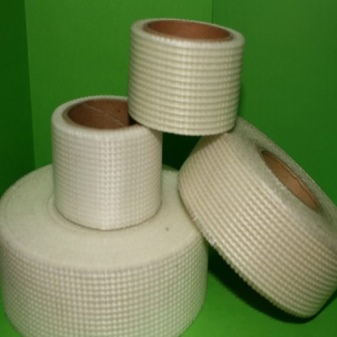
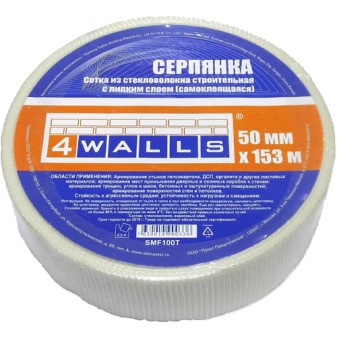
When buying a serpyanka, you should ask the manufacturer. Basically, it is made by domestic firms, and among them there are reliable and well-proven suppliers. We must not forget that cheap products may not be too solid, and this will certainly affect the entire quality of the finish.If the mesh is delaminated, this indicates poor quality or defective products. It will also be useful to check the adhesive layer.
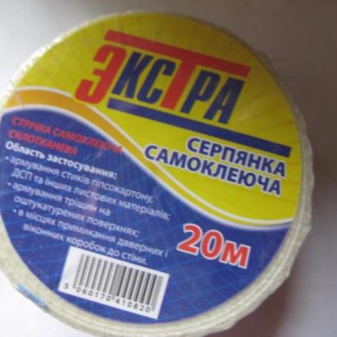
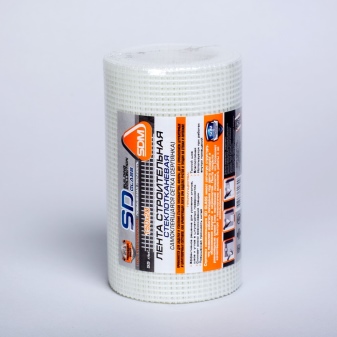
Types and characteristics of serpyanka
The product is a tape with a mesh structure. Most often, there are options with a width of 45-50 mm, there are also products up to 23 cm. It is produced in rolls with different meters, the length varies from 20 to 100 (150) m.
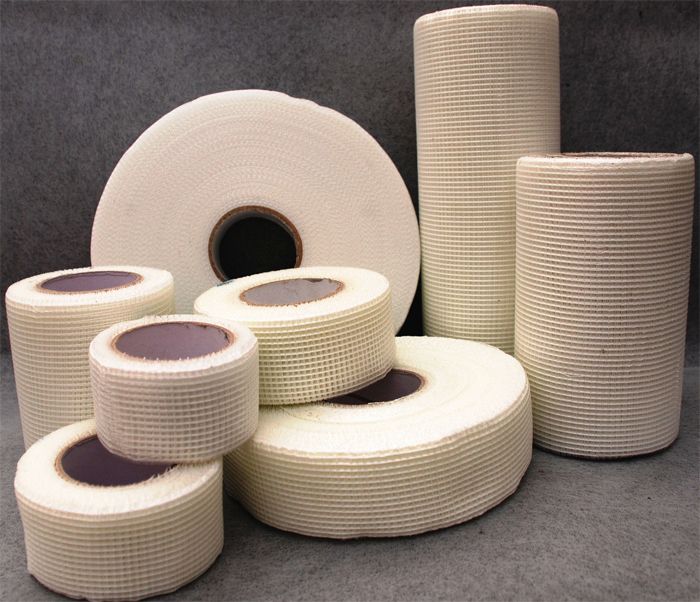 The length and width of the tape in the package is determined by the manufacturer, the minimum roll length is 10 m, there is no fixed maximum
The length and width of the tape in the package is determined by the manufacturer, the minimum roll length is 10 m, there is no fixed maximum
The material is divided into categories, depending on the method of gluing:
Self-adhesive. On the seamy side of the product, a composition is applied that provides quick adhesion to the surface
But you need to work with such a serpentine carefully: if the laying is done incorrectly, then after tearing off the product will lose its stickiness. By observing the nuances, the surface treatment time is significantly reduced.
Materials requiring the use of binders
The most popular variety, it is characterized by ease of work, high-quality results and a lower price compared to the previous version.
 Glueless and self-adhesive tapes differ only in price and in the presence of an adhesive layer, while the composition of the threads is absolutely identical
Glueless and self-adhesive tapes differ only in price and in the presence of an adhesive layer, while the composition of the threads is absolutely identical
There is also a division by size:
- Serpyanka with cells from 1 to 3 mm. Such products are used in interior work, providing a strong retention of the putty mixture, which guarantees the absence of even small cracks.
- Options with holes larger than 5 mm. It is preferable to glue such material when using starting solutions. The mesh is great for repairing gypsum boards.
The most popular is a serpyanka made of glass threads; there are also options from lavsan.
 There are several materials from which reinforcing tape is made, while fiberglass is still the most popular.
There are several materials from which reinforcing tape is made, while fiberglass is still the most popular.
Nuances of choice
Domestic producers of Serpyanka provide a large part of the Russian market, which makes it possible for the buyer to fairly focus on the popularity of the company and the stability of a large manufacturer. The main selection criterion is the price of the product. It is impractical to purchase a cheap mesh. Market prices for a product (no adhesive) start at about $ 1 per item. With glue application, the price of the roll increases slightly.

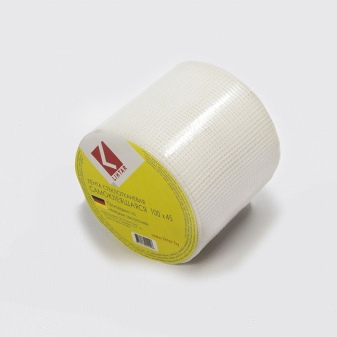
The surface of the product should be treated with a polyacrylic dispersion that successfully resists aggressive putty elements and maintains the integrity of the mesh. However, this mesh will not be the cheapest on the market.
In the buying process, pay attention to the integrity of the mesh. If it delaminates, then it's not your choice.
Such a defect indicates a marriage and low quality of the product. It is worth checking the condition of the glue coating of the network, it happens that it is susceptible to drying out. In other words, the packaging of goods in rolls must be guaranteed tight.
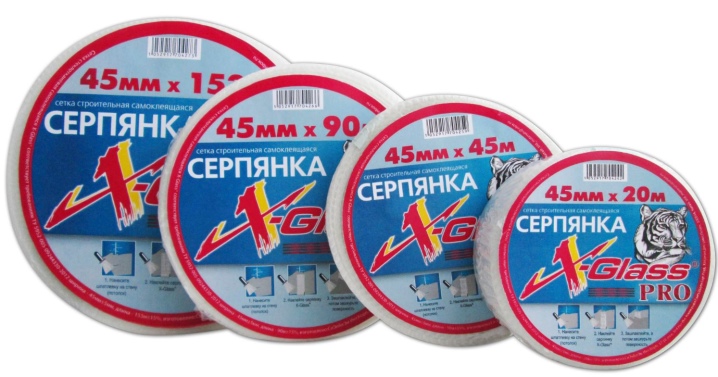
What is serpyanka and why is it needed
Serpyanka is a thin fiberglass tape in the form of a grid with rectangular meshes. The standard widths are 45, 50 and 100 mm, the footage is 20, 45, 90, 150 m. Usually, the manufacturer applies an adhesive composition to one of its sides, so that it is attached to the surface in the same way as masking tape.
Advantages of reinforcing mesh for drywall:
- Easy to use: glued without problems, cut with ordinary scissors.
- Does not lend itself to aggressive environments.
- Improves the strength characteristics of the surface. Fiberglass tape does not shrink, it tolerates vibration and displacement of individual elements well.
- It interacts well with putty, in combination with it provides a reliable connection.
- Cheap and affordable material.
In addition to strengthening the seams in drywall, self-adhesive reinforcing mesh is used:
- When sealing cracks in walls or ceilings.
- When finishing door or window slopes.
- When processing the places of abutment to the wall of the door frame.
Priming joints and mixing mortar
It is not enough to know how to putty the joints of drywall, because the primer also plays an important role. Deep penetration primer is used to clean the surface as well as for better adhesion
With the help of a brush, all joints are coated with a primer, and it does not matter what kind of edge they have (factory or homemade). The primer will serve as a connecting link, a kind of glue, between drywall and putty
Wait until the primer is completely dry.
Correctly mixed putty will be the key to successful work. Fugenfuller is a popular filler for drywall joints. However, not everyone chooses it due to the fact that it dries quickly. Although this statement is doubtful, because you need to be able to knead the solution. First, you need to knead the solution in small portions, calculating your strength. Secondly, if everything is done correctly, the putty will not dry out within 30-45 minutes. And this is quite enough for comfortable work.
The required amount of water is collected in a clean bucket (you need to look at the putty instructions) and then the finishing putty is added there. It should be poured as if it were flour. If you throw everything in a heap, then problem lumps are guaranteed. Many people argue about the best way to seal drywall seams without thinking about how they make this mixture.
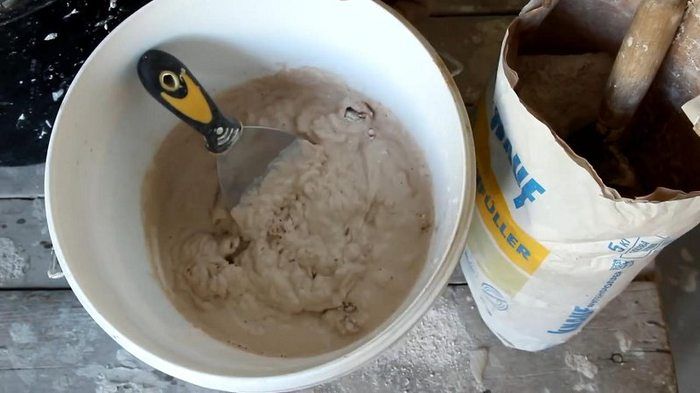 In the process of creating a mixture for sealing joints
In the process of creating a mixture for sealing joints
After the putty is carefully poured into a container of water, it is mixed with a spatula. Using a mixer will harden the mixture faster. Stir the Fugenfuller a little so that the entire putty is wet, and then leave it to swell for 5-10 minutes. After that, the drywall putty is thoroughly mixed with a spatula, and all the lumps are broken. The final mass should look like very thick sour cream. With the finished mixture, you need to start working immediately.
How to use serpyanka instruction
In total, there are two technologies for using serpyanka:
- The tape is immersed in a fresh layer of putty, one layer is applied on top of it.
- The tape is glued onto the already putty surface due to its adhesive coating. After that, a second coat is applied.
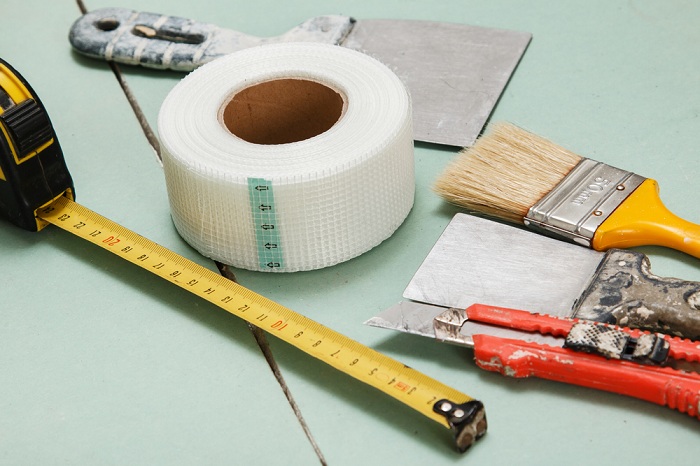
If gluing of non-native seams, end seams is required, then they require certain processing before use. The knife cuts off the edges on both sides, as a result of which the seam area increases. This is necessary for better adhesion of the putty to the surface. The resulting sections are subject to mandatory priming.
The native seam cannot be enlarged, provided that they are not damaged. In this case, the surface of drywall before applying the putty requires a decent layer of primer. This will ensure maximum adhesion of the plasterboard surface to the filler. If we are talking about the use of self-adhesive serpyanka with a sticky layer on the surface of the chips, then they also need preliminary cutting, priming and applying putty. Only after that should you start gluing the serpyanka over the layer of putty.
In no case should the tape be glued to the finishing layer of the putty, since the serpyanka is not intended for such an action. A layer of the mixture is always applied on top of the tape, which, after drying, is cleaned with a spatula and only then a thinner layer of putty is applied.
Serpyanka what is the video for?
Accordingly, self-adhesive serpyanka finds its application in many areas of construction and repair work. In this case, the main function of such a tape is the ability to prevent the occurrence of cracks and discrepancies at the joints and corners.
